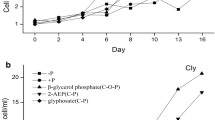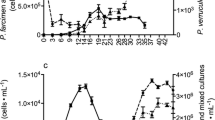Abstract
Growth interactions between the dinoflagellate Levanderina fissa (=Gyrodinium instriatum) and the other three algal bloom species Skeletonema costatum (Bacillariophyceae), Prorocentrum micans (Dinophyceae), and Chattonella marina (Raphidophyceae) were studied using bi- or tri-algal co-cultures under laboratory conditions. The Lotka-Volterra model was applied to estimate the interspecific competition between them. Results showed that the growth of L. fissa was significantly suppressed in both bi-algal and tri-algal cultures, and the maximum cell densities in co-cultures were only between 21% and 69% of that in mono-culture. L. fissa outcompeted P. micans; however, its effects on S. costatum and C. marina were generally less than the effects of their intraspecific competitions based on the competition coefficients. Contrarily, the inhibitory effects of S. costatum and C. marina on L. fissa were much greater. S. costatum outcompeted the other three species in all co-cultures, and its competition coefficients on the other species were more than 10000 times higher than the opposite. The growth of C. marina was suppressed by S. costatum; however, it outcompeted L. fissa and P. micans. The growth of P. micans was most strongly inhibited in co-cultures, and the maximum cell densities in co-cultures were less than 15% of that in mono-species culture. The results suggested that L. fissa had few advantages in the interspecific competition. The adaptation to low salinity and the utilization of organic phosphorus might be the important reasons for L. fissa to take the competitive predominance in brackish estuarine environments.
Similar content being viewed by others
References
Ahmad, S., 1993. On the nonautonomous Volterra-Lotka competition equations. Proceedings of the American Mathematical Society, 117: 199–204.
Armstrong, R. A., 2003. A hybrid spectral representation of phytoplankton growth and Zooplankton response: The ‘control rod’ model of plankton interaction. Deep-Sea Research Part II: Tropical Studies in Oceanography, 50: 2895–2916.
Berdalet, E., Fleming, L. E., Gowen, R., Davidson, K., Hess, P., Backer, L. C., Moore, S. K., Hoagland, P., and Enevoldsen, H., 2016. Marine harmful algal blooms, human health and wellbeing: Challenges and opportunities in the 21st century. Journal of Marine Biological Association of the United Kingdom, 96 (1): 61–91.
Carstensen, J., Klais, R., and Cloern, J. E., 2015. Phytoplankton blooms in estuarine and coastal waters: Seasonal patterns and key species. Estuarine Coastal and Shelf Science, 162 (SI): 98–109.
Cira, E. K., Paerl, H. W., and Wetz, M. S., 2006. Effects of nitrogen availability and form on phytoplankton growth in a eutrophied estuary (Neuse River Estuary, NC, USA). PLoS One, 11 (8): e0160663.
Fernandez-Herrera, L. J., Band-Schmidt, C. J., Lopez-Cortes, D. J., Hernandez-Guerrero, C. J., Bustillos-Guzman, J. J., and Nunez-Vazquez, E., 2016. Allelopathic effect of Chattonella marina var. marina (Raphidophyceae) on Gymnodinium catenatum (Dinophycea). Harmful Algae, 51: 1–9.
Garate-Lizarraga, I., Sevilla-Torres, G., Alvarez-Anorve, M., Aguirre-Bahena, F., Violante-Gonzalez, J., and Rojas-Herrera, A., 2013. First record of red tide caused by Gyrodinium instriatum (Dinophyceae: Gymnodiniales) in Bahia et Acapulco, Guerrero. Cicimar Oceanides, 28: 43–47.
Guillard, R. R. L., 1975. Culture of phytoplankton for feeding marine invertebrates. In: Culture of Marine Invertebrates Animals. Smith, W. L., and Chanley, M. H., eds., Plenum Press, New York, 26–60.
Hallegraeff, G. M., Munday, B., Baden, D., and Whitney, P., 1998. Chattonella marina (Raphidophyte) bloom associated with mortality of cultured bluefin tuna (Thunnus maccoyii) in South Australia. In: Harmful Algae. Reguera, B., et al., eds., 3 edition, Xunta de Galacia and IOC-UNESCO, Vigo, 93–96.
Handy, S. M., Hutchins, D. A., Cary, S. C., and Coyne, K. J., 2006. Simultaneous enumeration of multiple raphidophyte species by quantitative real-time PCR: Capabilities and limitations. Limnology and Oceanography-Methods, 4: 193–204.
Imai, I., 2012. High growth rates of the red tide flagellate Chattonella marina (Raphidophyceae) observed in culture. Bulletin of Fisheries Sciences Hokkaido University, 62 (3): 71–74.
Ji, X. Q., Han, X. T., Zheng, L., Yang, B. J., Yu, Z. M., and Zou, J. Z., 2011. Allelopathic interactions between Prorocentrum micans and Skeletonema costatum or Karenia mikimotoi in laboratory cultures. Chinese Journal of Oceanology and Limnology, 29: 840–848.
Jimenéz, R., 1993. Ecological factors related to Gyrodinium instriatum bloom in the inner estuary of the Gulf of Guayaquil. In: Toxic Phytoplankton Blooms in the Sea. Proceedings of the 5th International Conference on Toxic Marine Phytoplankton, Newport, Rhode Island, U.S.A., 28 October–1 November 1991. Smayda, T. J., and Shimizu, Y., eds., Elsevier, Amsterdam, 257–262.
Kang, Y., and Gobler, C. J., 2018. The brown tide algae, Aureococcus anophagefferens and Aureoumbra lagunensis (Pelagophyceae), allelopathically inhibit the growth of competing microalgae during harmful algal blooms. Limnology and Oceanography, 63 (2): 985–1003.
Kuroda, A., Nakashima, T., Yamaguchi, K., and Oda, T., 2005. Isolation and characterization of light-dependent hemolytic cytotoxin from harmful red tide phytoplankton Chattonella marina. Comparative Biochemistry and Physiology C-Toxicology & Pharmacology, 141: 297–305.
Lee, C. K., Park, T. G., Park, Y. T., and Lim, W. A., 2013. Monitoring and trends in harmful algal blooms and red tides in Korean coastal waters, with emphasis on Cochlodinium polykrikoides. Harmful Algae, 30S: S3–S14.
Lin, L., Wang, Z., Liang, J., and Jiang, X., 2013, Effects of temperature and salinity on the growth of Gyrodinium instriatum. Marine Environmental Science, 32 (1): 20–22 (in Chinese with English abstract).
Liu, W., Au, D. W. T., Anderson, D. M., Lam, P. K. S., and Wu, R. S. S., 2007. Effects of nutrients, salinity, pH and light:dark cycle on the production of reactive oxygen species in the alga Chattonella marina. Journal of Experimental Marine Biology and Ecology, 346: 76–86.
Matsubara, T., Nagasoe, S., Yamasaki, Y., Shikata, T., Shimasaki, Y., Oshima, Y., and Honjo, T., 2008. Inhibitory effects of centric diatoms on the growth of the dinoflagellate Akashiwo sanguinea. Nippon Suisan Gakk, 74 (4): 598–606.
Moestrup, Ø., Hakanen, P., Hansen, G., Daugbjerg, N., and Ellegaard, M., 2014. On Levanderina fissa gen. & comb. nov. (Dinophyceae) (syn. Gymnodinium fissum, Gyrodinium instriatum, Gyr. uncatenum), a dinoflagellate with a very unusual sulcus. Phycologia, 53: 265–292.
Nagasoe, S., Kim, D. I., Shimasaki, Y., Oshima, Y., Yamaguchi, M., and Honjo, T., 2006. Effects of temperature, salinity and irradiance on the growth of the red tide dinoflagellate Gyrodinium instriatum Freudenthal et Lee. Harmful Algae, 5: 20–25.
Nagasoe, S., Shikata, T., Yamasaki, Y., Matsubara, T., Shimasaki, Y., Oshima, Y., and Honjo, T., 2010. Effects of nutrients on growth of the red-tide dinoflagellate Gyrodinium instriatum Freudenthal et Lee and a possible link to blooms of this species. Hydrobiology, 651: 225–238.
Nishikawa, T., Hori, Y., Nagai, S., Miyahara, K., Nakamura, Y., Harada, K., Tada, K., and Imai, I., 2014. Long-term (36-year) observations on the dynamics of the fish-killing raphidophyte Chattonella in Harima-Nada, eastern Seto Inland Sea, Japan. Journal of Oceanography, 70: 153–164.
Qi, Y. Z., Chen, J. F., Wang, Z. H., Xu, N., Wang, Y., and Shen, P. P., 2004, Some observations on harmful algal bloom (HAB) events along the coast of Guangdong, southern China in 1998. Hydrobiologia, 512: 209–214.
Qi, Y. Z., and Huang, C. J., 1997. The causative mechanism of Chattonella marina bloom in Dapeng Bay, the South China Sea. Oceanology et Limnology Sinica, 28 (4): 337–342 (in Chinese with English abstract).
Qiu, X., Yamasaki, Y., Shimasaki, Y., Gunjikake, H., Matsubara, T., Nagasoe, S., Etoh, T., Matsui, S., Honjo, T., and Oshima, Y., 2011. Growth interactions between the raphidophyte Chattonella antiqua and the dinoflagellate Akashiwo sanguinea. Harmful Algae, 11: 81–87.
Qiu, X. C., Shimasaki, Y., Yoshida, Y., Matsubara, T., Yamasaki, Y., Kawaguchi, M., Honda, M., Mouri, K., Nakajima, Y., and Tasmin, R., 2014. Allelopathic effects of Skeletonema spp. may influence interspecific competition and bloom formation of co-occurring harmful flagellates. Journal of the Faculty of Agriculture Kyushu University, 59 (2): 373–381.
Shen, M., Xu, J., Tsang, T. Y., and Au, D. W. T., 2010. Toxicity comparison between Chattonella marina and Karenia brevis using marine medaka (Oryzias melastigma): Evidence against the suspected ichthyotoxins of Chattonella marina. Chemosphere, 80: 585–591.
SOC (State Oceanic China), 2002, 2004, 2005. Bulletin of marine environmental quality. http://www.coi.gov.cn/gongbao/huanjing/ (in Chinese).
Vargas, E. C., Artavia, K. B., and Abarca, J. B., 2016. Harmful algal blooms during 2008–2010 in the Gulf of Nicoya, Costa Rica. Revmar-Revista Ciencias Marinas Y Costeras, 8 (1): 129–149.
Wang, R., Wang, J. T., Xue, Q. N., Sha, X. Y., Tan, L. J., and Guo, X., 2017a. Allelopathic interactions between Skeletonema costatum and Alexandrium minutum. Chemistry and Ecology, 33 (6): 485–498.
Wang, Z., Guo, X., Ou, L. J., and Lin, L. C., 2017b. Effects of nitrogen and phosphorus on the growth of Levanderina fissa: How it blooms in Pearl River Estuary. Journal of Ocean University of China, 16: 114–120.
Wang, Z. H., Jiang, S., Gu, Y. G., Kang, W., Feng, J., Lin, L. C., Shao, J., and Zhang, K., 2011. Effects of Cochlodinium bloom in Pearl River Estuary in China on the growth of other harmful algal bloom species. Journal of Shenzhen University Science and Engineering, 28 (6): 553–558 (in Chinese with English abstract).
Wang, Z. H., Yuan, M. L., Luo, Y. M., and Zhao, J. G., 2010. Studies on interspecies competition of Chattonella marina with Skeletonema costatum and Scrippsiella trochoidea in Laboratory cultures. Acta Hydrobiologica Sinica, 34 (2): 336–344 (in Chinese with English abstract).
Wood, S. A., Borges, H., Puddick, J., Biessy, L., Atalah, J., Hawes, I., Dietrich, D. R., and Hamilton, D. P., 2017. Contrasting cyanobacterial communities and microcystin concentrations in summers with extreme weather events: Insights into potential effects of climate change. Hydrobiology, 785 (1): 71–89.
Yamasaki, Y., Nagasoe, S., Tameishi, M., Shikata, T., Zou, Y., Jiang, Z., Matsubara, T., Shimasaki, Y., Yamaguchi, K., Oshima, Y., Oda, T., and Honjo, T., 2010. The role of interactions between Prorocentrum minimum and Heterosigma akashiwo in bloom formation. Hydrobiologia, 641 (1): 33–44.
Yamasaki, Y., Ohmichi, Y., Shikata, T., Hirose, M., Shimasaki, Y., Oshima, Y., and Honjo, T., 2011. Species-specific allelopathic effects of the diatom Skeletonema costatum. Thalassas, 27 (1): 21–32.
Zhang, Y. H., Fu, F. X., Whereat, E., Coyne, K. J., and Hutchins, D. A., 2006. Bottom-up controls on a mixed-species HAB assemblage: A comparison of sympatric Chattonella subsalsa and Heterosigma akashiwo (Raphidophyceae) isolates from the Delaware Inland Bays, USA. Harmful Algae, 5 (3): 310–320.
Zhao, Y., Yu, Z., Song, X., and Cao, X., 2009. Biochemical compositions of two dominant bloom-forming species isolated from the Yangtze River Estuary in response to different nutrient conditions. Journal of Experimental Marine Biology and Ecology, 368 (1): 30–36.
Zhu, C., and Yin, G., 2009. On competitive Lotka-Volterra model in random environments. Journal of Mathematical Analysis and Applications, 357: 154–170.
Zhu, X., Yi, B., Dong, Y., and Yan, L., 2004. A primary study on one of the ‘bilateral’ red tide at Chi Bay of Pearl River Estuary. Marine Environmental Science, 23: 41–44 (in Chinese with English abstract).
Acknowledgement
This research was financially supported by the National Natural Science Foundation of China (No. 4147 6132).
Author information
Authors and Affiliations
Corresponding author
Rights and permissions
About this article
Cite this article
Wang, Z., Zhao, J., Xiao, L. et al. Interspecific Competition Between Levanderina fissa (Dinophyceae) and the Other Three Microalgal Species in Co-Cultures. J. Ocean Univ. China 18, 919–925 (2019). https://doi.org/10.1007/s11802-019-3951-1
Received:
Revised:
Accepted:
Published:
Issue Date:
DOI: https://doi.org/10.1007/s11802-019-3951-1




